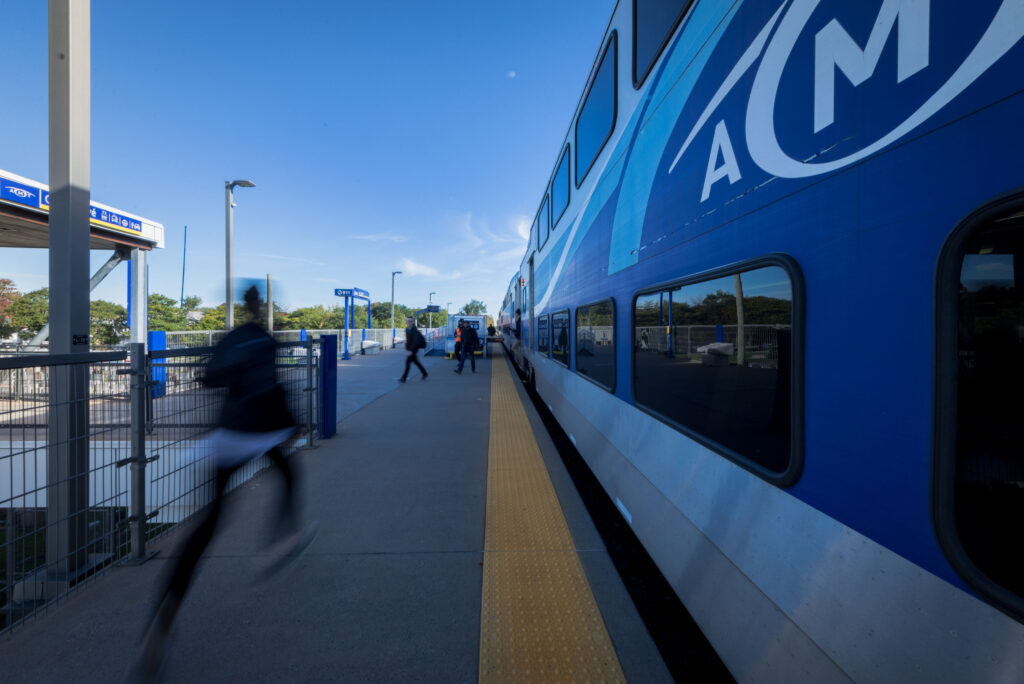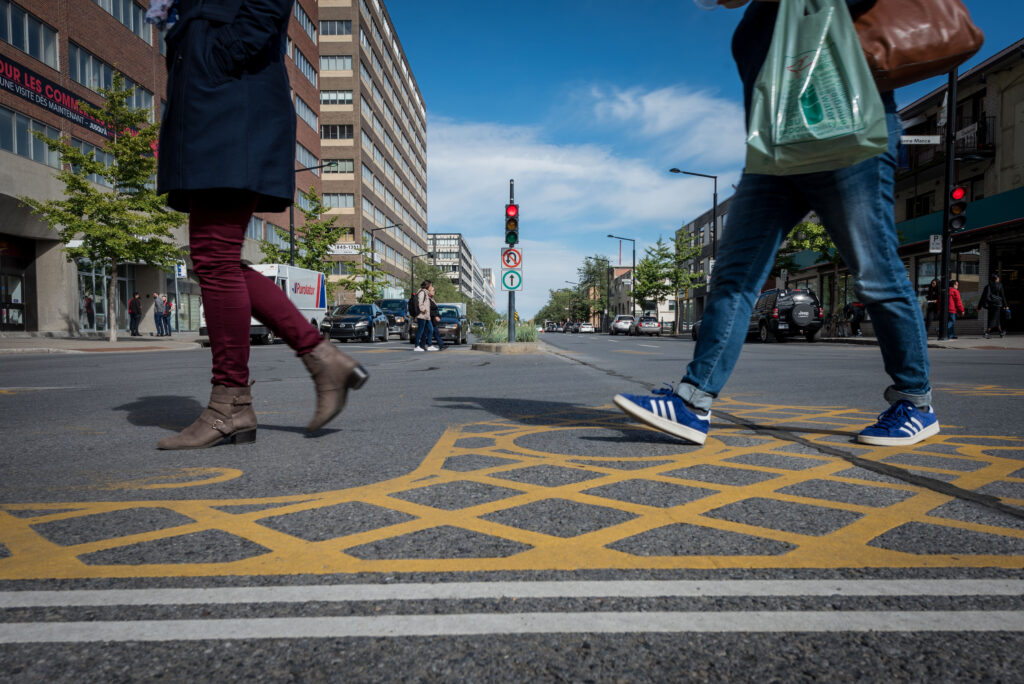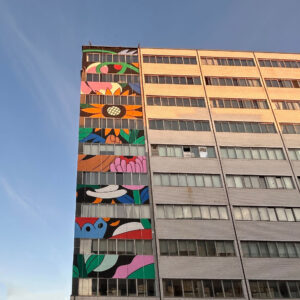NEWS FROM RIGHT HERE
January 31, 2023
Creating Pathways
Mobility is intrinsically linked to development and land use planning. Together, these concepts define the environments in which thousands of people and businesses lead their daily lives. They can also influence the redevelopment efforts of certain neighbourhoods. Having understood this, the SDC District Central established a mobility committee in 2017. From one initiative to the next, the committee has since managed to develop a vision consistent with the realities and aspirations of the District Central and its occupants. This vision recently earned the SDC recognition as a leader in sustainable mobility by the centres de gestion de déplacement de Montréal: a brief history of great mobilization.
Covering three square kilometres, the District Central is bound by Sauvé and Berri streets and highways 15 and 40. The territory benefits by the presence of three nearby commuter train stations and two metro stations, to which will soon be added a réseau express métropolitain (REM) station. Despite this public transit infrastructure and easy access to major thouroughfares, as early as 2017, the socioeconomic stakeholders involved in the neighbourhood’s redevelopment felt the need to set up a mobility committee. “Very quickly the issue of access to the territory and mobility were identified as priorities by the members of the Board of Directors,” relates Hélène Veilleux, Executive Director of the SDC District Central.
The shortage of workers that local businesses were experiencing and the need for large property owners to find tenants for their numerous vacant spaces served as the catalyst for this movement. “Entrepreneurs wanted to make the territory attractive, and beyond the actual infrastructure, interconnections were needed to make it quick and easy to get to the District,” explains the executive director.
This view is shared by Martine Peyton, urban planner and consultant to the SDC since the beginning of the requalification efforts and president of ÉLÉMENTS Planification urbaine. “The ease with which a trip can be made has a huge impact on people’s perception and on the choices they make regarding transportation. In the District Central, not only are the connections between metro stations and bus routes not ideal, but active mobility is not necessarily a pleasant experience. Traveling by bicycle is also relatively risky,” she argues.
These issues have been the basis for many consultations by the SDC.
“From the very beginning, explains Hélène Veilleux, we reached out to people. We listened to them explain the difficulties they encountered and the solutions they envisioned to remedy them. Extraordinary ideas came out of these sessions, but above all we understood that it was impossible to change behaviour without considering the particularities of the territory.”
For Christian Savard, Executive Director of Vivre en ville, there is no doubt that when it comes to planning and mobility, it is essential to “take into account the context in which the solutions must be implemented. One-size-fits-all does not work.”
Act locally, think globally
In keeping with the mixed-used character of the District Central, the SDC has increased its mobility initiatives in recent years. In collaboration with the Société de transport de Montréal, the service offer for public transit by bus has been expanded. Various awareness activities related to sustainable modes of transportation were organized. Communication campaigns highlighting the benefits of sustainable mobility were also deployed on social networks and within businesses.
On another level, the SDC also lobbied for the connection of the REM to the District Central and actively participated in the work for the development of a transit-oriented development (TOD) area around the Ahunstic and Chabanel stations. The arguments put forward in support of these representations have paid off.
“For many years, even though it is the fourth largest employment hub in the city, the District Central hasn’t appeared in the City’s development plans,” admits Martine Peyton. The SDC’s advocacy efforts have changed that. The sector’s full potential is now recognized, and changes are beginning to be felt on the ground.”
Recently, the Ville confirmed its intention to equip the sector with a first stretch of bicycle paths. This announcement comes at a time when the SDC is working on the implementation of a mileage allowance program for workers using electric bikes and with the arrival of BIXI stations on the territory. With the support of MOBA/Mobilité Active and clicknpark, a pilot project to share off-street parking is also set to launch. The latter will allow users to reserve a parking space remotely, via an app, for a given period at a predetermined rate. Eventually, the SDC hopes that both private and public parking lots and spaces will also be included in the options available to users.
Hélène Veilleux does not hide the fact she hopes to mitigate the impact that the implementation of the bike path on the territory for motorists. “The addition of a bike path is excellent news for the sector, but we can’t bury our heads in the sand either. It will have an impact on the number of available parking spaces. Like it or not, many people still rely on cars to get around. On-street businesses receive deliveries, while others make them. If we want the integration of cycling in the area to go well, we need to take all these factors into account.”
A sound approach, according to Martine Peyton. “Despite all efforts to encourage the use of more environmentally friendly modes of transportation, the truth is that until viable travel options become available, the automobile will continue to be very important. This reality cannot be ignored. We must ensure a harmonious coexistence.” The Ville de Montréal itself, as part of the consultation process to develop its next urban planning and mobility plan, said that the modal share of the automobile could remain at around 50% until 2036.[1]
Supporting change
For Christian Savard, the key is to rely on collective intelligence. “For a long time, it was all about the car, however, the environmental context no longer leaves us a choice. We need to rebalance things to make room for other modes of transport. It can be tempting to say that it’s too complicated that it’s better to leave well enough alone, but I believe that we need to tackle it head on. For me, the solution lies in good planning and the diversity of the actors involved. There can be no simple answer to a complex problem, and it takes many heads to bring about change,” he insists.
The collaborative approach described by the executive director of Vivre en ville is at the heart of the SDC’s actions. The honour of “Federator” granted as part of the Leaders in Sustainable Mobility 2022 awards, reflects just that.
“I’ve said it many times, consultation makes the difference between a successful transformation driven by a majority of people and an imposed plan that inevitably fails after a while because it doesn’t make sense to the people involved. In my opinion, the same goes for sustainable mobility,” asserts Hélène Veilleux.
However, the executive director does not hide the fact that this approach requires a healthy dose of courage. “Finding real solutions that will stand the test of time requires asking tough questions and acknowledging problems and challenges. This can be very uncomfortable, but the truth is that issues don’t go away because you choose to ignore them. It’s better to take the time to find the right response to the situation than to risk having innovative projects compromised because we wanted to move too quickly.”
Planning consultant Martine Peyton is adamant that “taking the time saves time”. In terms of mobility, this can mean discussing the best possible route for a bike path with all stakeholders, including motorists, before executing the work. It means working on the sharing of parking lots, recognizing that some trips will still have to be made by car or truck. It means taking advantage of every opportunity to redesign the area to include elements that promote active mobility, such as trees and wider sidewalks. It means rethinking traffic lanes to promote coexistence and increase safety. It means understanding the need to explain in clear terms the challenges associated with certain solutions.
Above all, concludes Hélène Veilleux, it means accepting that no change is possible without a transition period. It means choosing to accompany and support rather than impose. It means accepting that sustainability is based on commitment and there is no commitment without investment.
“You can have big ambitions and hope that people will follow you, or you can share your goals and make sure to find ways to get there. Of the two, the latter is the approach the SDC chooses to follow. It is what allows us to envision a revitalized and accessible District Central five years down the line, with an integrated and coherent transportation offer. A sustainable transportation offer.”
Translated from an article written by Guylaine Boucher
[1] Projet de ville, Ville de Montréal, p. 45.
Redesigning the city: the challenge facing District Central
Business parks, tomorrow. That was the theme that brought together economic stakeholders from the Brittany region on December 2. On this occasion, Hélène Veilleux, Executive Director of the SDC District…
Read MoreA Look Back at Our 2025 Year-End Cocktail
On November 26, the District Central community gathered at Brasserie Silo to celebrate the close of a year filled with strong collaborations, impactful projects, and collective achievements. This festive evening…
Read MoreA New Sculptural Mural in District Central
A unique new mural with a sculptural component is well worth a visit in District Central. The artwork, titled Ligne de vie urbaine, was created by Montreal-based artist DALKHAFINE and…
Read More








